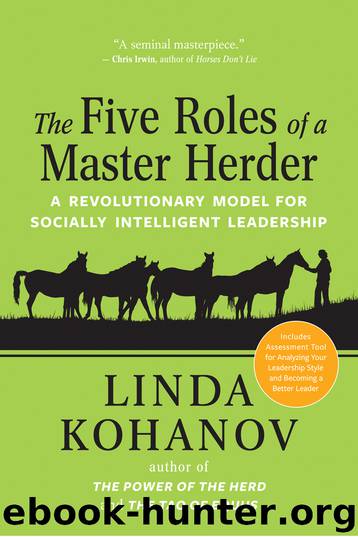The Five Roles of a Master Herder by Linda Kohanov

Author:Linda Kohanov
Language: eng
Format: epub
Publisher: New World Library
A Dangerous Place
At the opposite end of the spectrum, we see dysfunction take hold of people who neglect or actively avoid developing proficiency in nurturing and companionship skills. Remember: The computer software company that hired sociometrist Greg Reid wasn’t just concerned about Melanie’s seemingly low productivity; management also wanted insight into the high-performing yet socially inhibited “curmudgeons.” Intellectual geniuses who hide in their offices are less likely to hold leadership positions, and they are more likely to experience interpersonal and motivational complications if they are promoted. But that’s just the tip of the iceberg. As history shows over and over again, the world becomes a very dangerous place when powerful people abdicate the Nurturer/Companion role. Even worse, leaders who overemphasize the Predator and Dominant roles create social structures that devalue — and in certain contexts practically outlaw — compassionate, collaborative, life-enhancing behavior.
At this point, I could list thousands of sadistic dictators and terrorist organizations from modern times right on back through the dawn of civilization. But I’d like to offer an unconventional view of how and why this happens through a timely case study: Fulani men who, either by force or choice, give up their herds for an urban lifestyle.
Though the Fulani’s origins are sketchy, these tribes “apparently began their penetration of the study area in northern Nigeria between AD 1350 and 1450,” Dale Lott and Benjamin Hart wrote in the 1979 article I cited earlier. “At the time of the European colonization of the area they had achieved political domination of virtually all the local populations, although they were outnumbered at least four to one.” History therefore suggests that the ability of a single herder to hold his own with an angry Fulani bull one minute, herd several dozen cattle away from tempting crops the next, and lead them all happily back to camp at the end of the day has significant repercussions for leading and/or dominating large groups of people as well.
But remember, like all pastoralists, the Fulani traditionally spend much more time engaging in nurturing and sentinel activities than in dominant, leadership, or predator-based behavior. Caring for animals releases oxytocin, buffering fight-or-flight instincts in favor of a calm-and-connect response.
When these people are separated from their cattle, however, the hormone no longer modulates the aggressive energy that young herders eventually transform into mature assertiveness. City-based Fulani women continue to experience an oxytocin release in childbirth, milk production, and caring for their families. But adolescent males in particular lack the biochemical support to soften and socialize their immense power once they no longer have daily contact with their animals.
“The Fulani’s formula of intimacy and aggression, courage and understanding, sounds like a description of how oxytocin and vasopressin promote social interactions,” Meg Daley Olmert contends in Made for Each Other. “We know that oxytocin can flow between humans and animals, and it’s possible that vasopressin does as well.” However, when the calm-and-connect response of oxytocin is dramatically reduced, if not removed, from an adolescent Fulani male’s system due to loss
Download
This site does not store any files on its server. We only index and link to content provided by other sites. Please contact the content providers to delete copyright contents if any and email us, we'll remove relevant links or contents immediately.
Sapiens: A Brief History of Humankind by Yuval Noah Harari(13054)
The Tidewater Tales by John Barth(12030)
Do No Harm Stories of Life, Death and Brain Surgery by Henry Marsh(6337)
Mastermind: How to Think Like Sherlock Holmes by Maria Konnikova(6236)
The Thirst by Nesbo Jo(5786)
Why We Sleep: Unlocking the Power of Sleep and Dreams by Matthew Walker(5644)
Sapiens by Yuval Noah Harari(4538)
Life 3.0: Being Human in the Age of Artificial Intelligence by Tegmark Max(4509)
The Longevity Diet by Valter Longo(4446)
The Rules Do Not Apply by Ariel Levy(3906)
The Immortal Life of Henrietta Lacks by Rebecca Skloot(3826)
The Body: A Guide for Occupants by Bill Bryson(3802)
Why We Sleep by Matthew Walker(3773)
Animal Frequency by Melissa Alvarez(3755)
Yoga Anatomy by Kaminoff Leslie(3702)
Barron's AP Biology by Goldberg M.S. Deborah T(3632)
The Hacking of the American Mind by Robert H. Lustig(3580)
All Creatures Great and Small by James Herriot(3517)
Yoga Anatomy by Leslie Kaminoff & Amy Matthews(3396)
